Efficiency Improvement of Observation and Analysis of Microorganisms Such as Moulds and Bacteria
Microorganisms are used for food and pharmaceutical manufacturing. This is because fermented foods and medicines using microorganisms are beneficial for human bodies. At the same time, the development of unwanted microorganisms can lead to rot or contamination, impairing product quality or consumer health.
This section introduces basic knowledge of moulds (filamentous fungi) and bacteria and also introduces the latest examples of microorganism observation and analysis using our 4K digital microscope that improves the sophistication and efficiency of food and pharmaceutical quality control, quality assurance, research, and development.
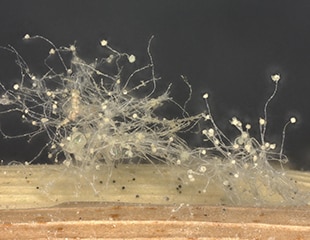
- Representative Kinds of Microorganisms
- Sizes of Microorganisms, Such as Bacteria and Fungi, and Problems in Observation and Analysis
- Usage Examples of Our 4K Digital Microscope in Microorganism Observation and Analysis
- A 4K Digital Microscope That Improves the Sophistication and Efficiency of Microorganism Observation and Analysis
Representative Kinds of Microorganisms
The representative kinds of microorganisms that are effectively used for food and pharmaceutical manufacturing or that can impair quality are explained below.
Bacteria
Bacteria, which are unicellular organisms each consisting of a single biological cell, are prokaryotes in which the chromosomes (DNA) in a cell are not encapsulated in a nuclear envelope. Bacteria multiply by replicating themselves as long as they have a nutritional source. This is called the self-replication ability. Typical bacteria are approximately 1 μm in size and can be observed using microscopes.
Bacteria beneficial to humans include lactic acid bacteria, bacillus subtilis natto, and acetic acid bacteria. Typical bacteria that can produce diseases in humans include Escherichia coli, Staphylococcus aureus, and Mycobacterium tuberculosis. Medicines to kill these bacteria after the infection are bactericides such as antibiotics. During quality inspection, foods and other similar products are checked to determine if they contain bacteria that can produce diseases and how these bacteria grow with time.
Fungi
Fungi—which include moulds, yeasts, and mushrooms—are kinds of eukaryotes in which the chromosomes (DNA) are encapsulated in a nuclear envelope. Moulds are sometimes collectively called fungi. Fungi are approximately 5 μm in size, midway between a human cell and a bacterium.
Filamentous fungi
Filamentous fungi, kinds of fungi, are formed with hyphae getting together, such as moulds and mushrooms. A hypha is a long filamentous structure that forms a body of fungi.
Yeasts
Yeasts are kinds of filamentous fungi, but they are spherical in shape, instead of being formed with hyphae. Many yeasts decompose sugar into alcohol and carbon dioxide in the absence of oxygen, while synthesising various amino acids in the presence of oxygen. With these abilities, yeasts have been used for brewing and manufacturing of miso, soy sauce, bread, and other fermented foods since a long time ago. Representative yeasts in practical use include beer yeasts, sake yeasts, wine yeasts, bread yeasts, and medical yeasts (dried yeasts).
Koji moulds
Koji moulds, originating in East Asia and Southeast Asia, are kinds of filamentous fungi that are encouraged to grow for use as koji (a malt-like material). Together with yeasts, koji is used in the brewing of sake and the manufacturing of other foods and beverages. Koji moulds decompose cereals—such as rice, barleys, and soybeans—to sugar and amino acids, which are then decomposed by yeasts. Japan has produced various fermented foods and beverages—such as sake, miso, soy sauce, and vinegars—using the characteristics of koji moulds since a long time ago.
Spore forming bacteria
Spore forming bacteria are resistant to heat processing, and thus are also called thermoduric bacteria. Typical spore forming bacteria that can cause food poisoning include Bacillus cereus, Clostridium perfringens, and Clostridium botulinum. A spore in bacteria is encapsulated in a hard coat. Spores are formed in environments inhospitable for moulds, such as dry environments and those with high temperatures or poor nutrition for moulds. Spores that are still alive in foods after washing, cooking, or heat sterilisation can spoil the foods or cause food-poisoning.
Sizes of Microorganisms, Such as Bacteria and Fungi, and Problems in Observation and Analysis
The following figure shows a size comparison between bacteria, fungi, and human cells. Bacteria, each having simple structures of a single cell, are only a tenth the size of human cells, which have complex structures. Fungi, which have chromosomes encapsulated in a nuclear envelope, have sizes midway between human cells and bacteria.

- A
- Bacteria
- B
- Fungi
- C
- Human cells
- D
- Viruses
Problems in microorganism observation and analysis
Bacteria and fungi are all very small microorganisms ranging in size from 1 μm to 5 μm. To evaluate them, accurate and difficult operations are required, such as magnified observation of cultivated organisms using microscopes and calculation of the number of organisms by precisely counting the number of microscopic colonies that have formed.
The first thing to do for these operations is to capture clear images of the target at high magnifications under the optimal lighting conditions. Many microorganisms, however, are highly transparent, decreasing their contrast against the background. Filamentous fungi grow in three dimensions, making it difficult to focus on the entire field of view to observe the target clearly. Condition determination for high-magnification observation and accurate quantitative analysis are even more difficult for small bacteria.
These operations depend on the skills of operators and their experience in observation and analysis. Even for experienced operators, it takes a lot of time and effort to determine conditions and obtain analysis results. Hence, it is difficult to secure human resources and control man-hours.
Usage Examples of Our 4K Digital Microscope in Microorganism Observation and Analysis
Up to now, it has been difficult to observe microorganisms using clear images and analyse them with no variation.
KEYENCE has developed a microscope that solves various problems and enables sophisticated observation and analysis with simple operations.
The VHX Series 4K digital microscope uses an optical system that combines high resolution with a large depth of field, a 4K CMOS image sensor, and an observation system that provides various functions with simple operations.
Read on for introductions to examples of observation and analysis of microorganisms, such as bacteria, moulds, and yeasts, using the VHX Series.
Observation of bacteria
Some bacteria, such as Escherichia coli and Staphylococcus aureus, can impair health when introduced to human bodies. Each having only a single cell, bacteria are small, 1 μm in size, thus requiring high magnification and high contrast to observe their colonies in cultivation. However, transparent bacteria make it difficult to determine lighting conditions, making their observations require a high level of skill and a significant amount of time.
The VHX Series 4K digital microscope can create various lighting conditions with a single unit. This microscope is equipped with the Multi-lighting function, which automatically obtains the data of multiple images with omnidirectional lighting at the press of a button. Observation can be started promptly simply by selecting an image suitable for the purpose. This function not only simplifies difficult condition determination but also greatly reduces the time required therein.
Various lighting conditions, such as transmitted polarising illumination and coaxial partial illumination, are available for observing bacteria with low contrast against the background, which were difficult to observe until now.
Additionally, the High Dynamic Range (HDR) function, which combines together multiple images captured at varying shutter speeds to acquire an image with high colour gradation, allows bacteria to be observed with high-resolution, high-contrast 4K images.
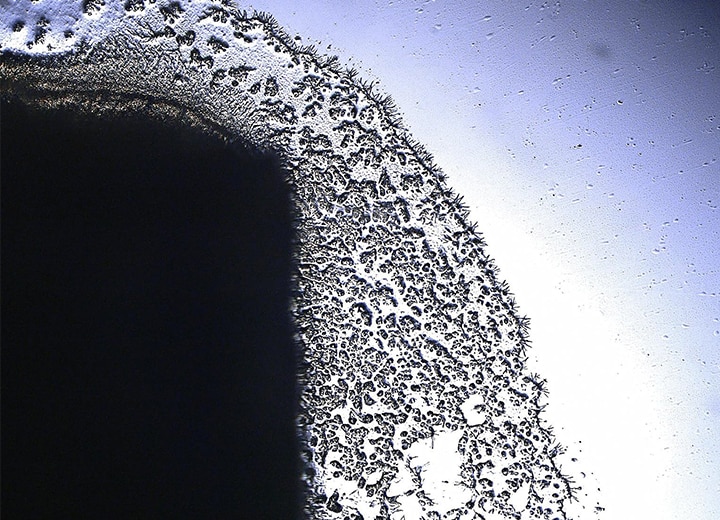
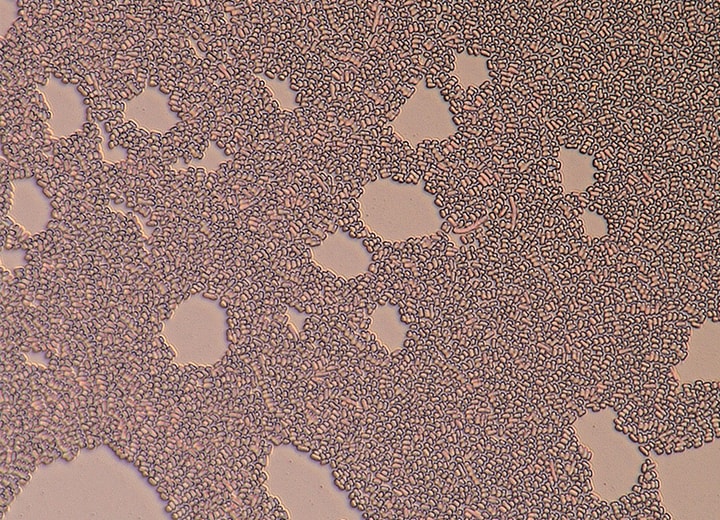
Observation and automatic analysis of bacteria
The VHX Series 4K digital microscope can seamlessly switch from high-magnification observation of bacteria using a high-resolution 4K image to automatic analysis.
The automatic area measurement/count function automatically measures and calculates detailed values—such as the average area, standard deviation, maximum value, minimum value, area ratio, and other items related to bacteria in the selected area as well as the accurate count, area, perimeter, maximum diameter, and minimum diameter of the bacteria—and then displays these values in a list.
In the selected area, targets that are not required can be excluded, overlapping targets can be separated, and binarisation can be applied to targets at arbitrary thresholds, which enables highly accurate analysis and quantitative evaluation with ease.
Additionally, Excel can be installed directly on the VHX Series, enabling images and values to be output and laid out in an arbitrary template, creating a report automatically without using a PC.
These functions greatly streamline the series of operations that required a lot of time and effort until now.
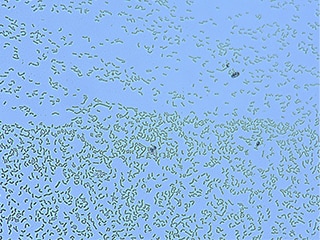
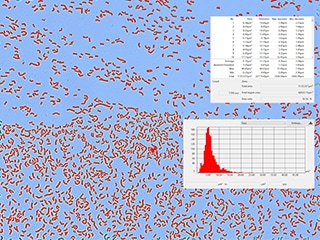
Observation of moulds including spores and hyphae
The VHX Series 4K digital microscope supports various observation conditions with a single unit, enabling observation using high-resolution 4K images. The Multi-lighting function enables observation under various lighting conditions with the simple operation of pressing a button. The large depth of field allows the entirety of a three-dimensional target, such as spores and hyphae, to be brought into focus.
Observation examples of moulds, their spores, and hyphae under various lighting conditions and using highly functional lenses and the 4K CMOS image sensor provided by the VHX Series are introduced below.
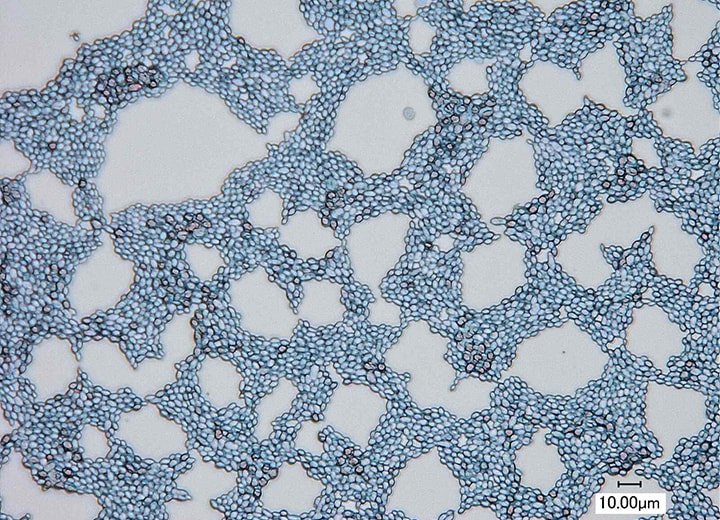
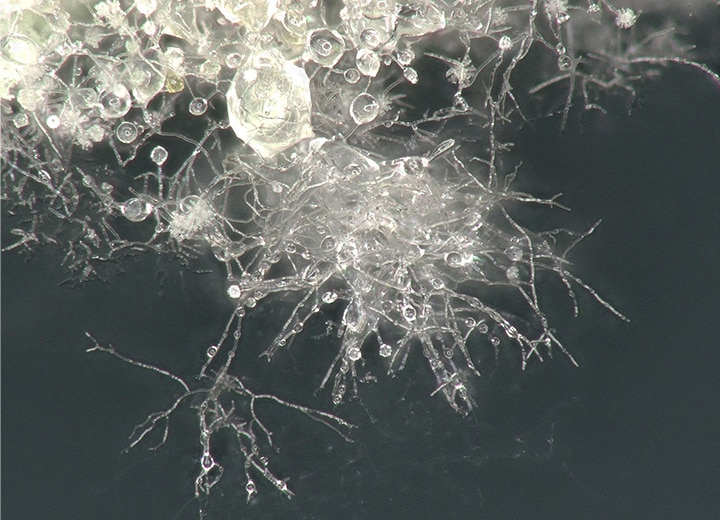
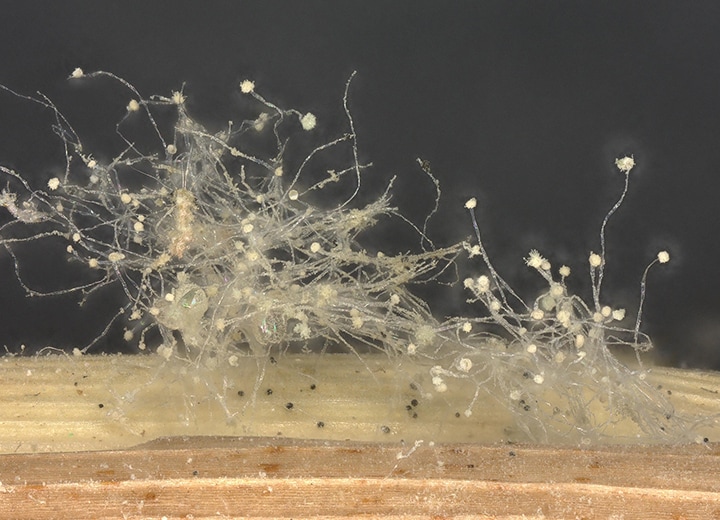
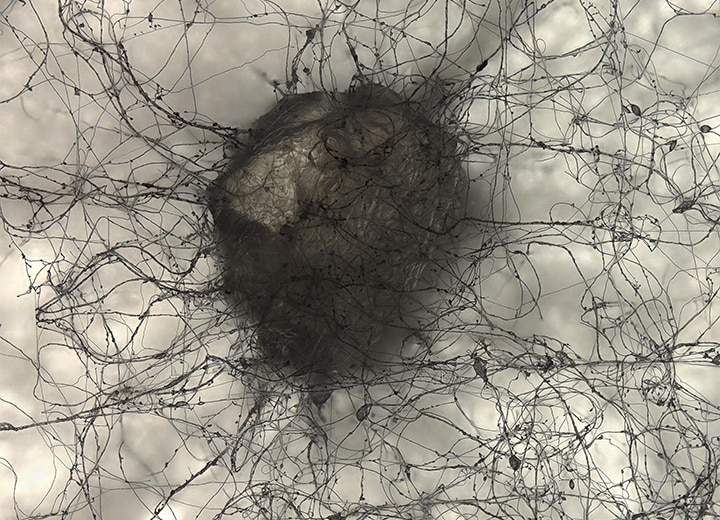
Automatic counting of yeast colonies
The VHX Series 4K digital microscope can capture clear 4K images at high magnifications even on microscopic targets like yeast colonies.
Using the automatic area measurement/colony count function for a captured high-resolution image enables automatic colony counting and area measurement in a specified area with high reproducibility. Various methods are available for displaying captured images such as a split display in which colonies in a specified area are displayed individually, a bar graph of area distribution, and binarisation at arbitrary thresholds, which significantly improves the efficiency of analysis work.
Excel can be installed directly on the VHX Series, enabling data output without using a PC. A report can be automatically created by outputting the number of bacteria calculated using the counted colonies, together with a corresponding image, to a template prepared in advance.
The VHX Series makes these various functions accessible with simple operations, quickly supporting a series of operations in yeast evaluation with a single unit.
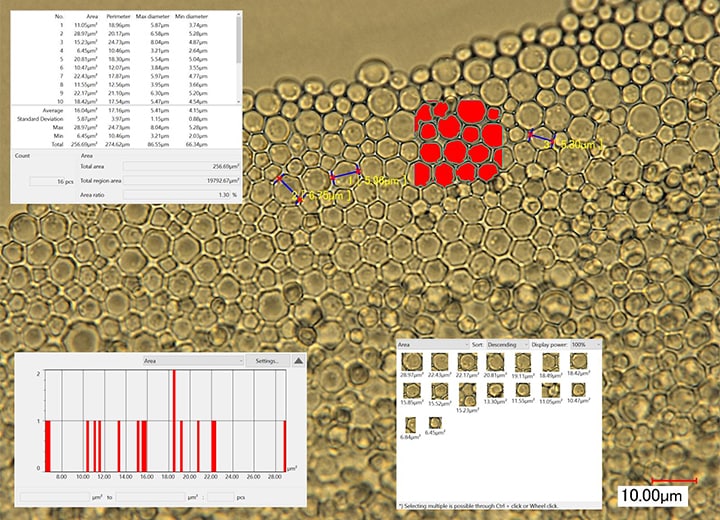
Observation of microorganisms in fluids
The VHX Series 4K digital microscope expresses its performance and functionality with samples under various conditions.
The 4K images shown below are observation examples of microorganisms in fluids. Even microorganisms in fluids can be clearly observed by using the built-in backlight as long as they are in a light-permeable container such as a glass bottom dish. Thanks to this product’s high focusing ability, clear 4K images of unwashed microorganisms can be captured even when they are mixed with a small amount of foreign particles in fluids.
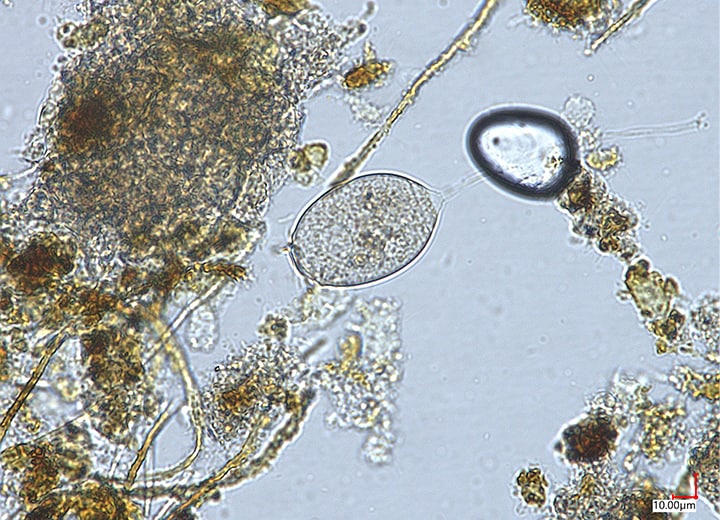

A 4K Digital Microscope That Improves the Sophistication and Efficiency of Microorganism Observation and Analysis
The VHX Series 4K digital microscope solves the problems in observation and analysis of microorganisms having various sizes and shapes, enabling sophisticated observation and quantitative analysis with simple operations.
This microscope can automatically perform the series of operations from condition determination and focus adjustment in observation, counting and measurement in analysis, to report creation—which are difficult and require much time and effort—with a single unit, eliminating overspecialisation and greatly reducing the required man-hours.
The VHX Series’ high performance, functionality, and usability can be used for various applications—such as quality control, quality assurance, research, and development—in food and pharmaceutical manufacturing as well as in quantitative evaluation of microorganisms.
The VHX Series is equipped with many other functions. For additional info or inquiries about the VHX Series, click the buttons below.


